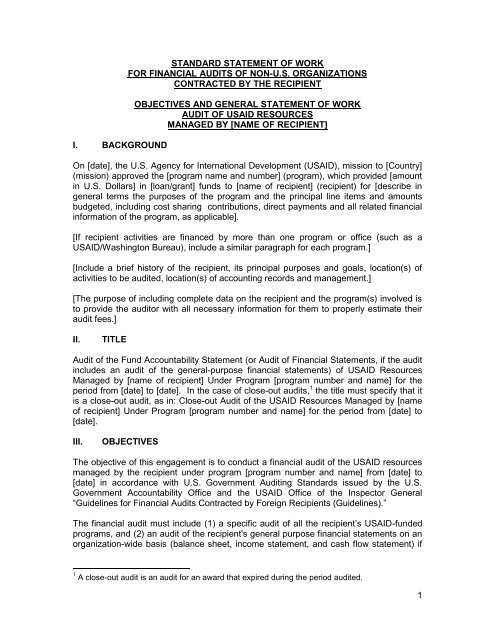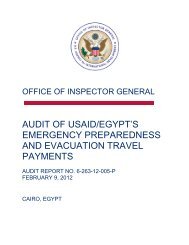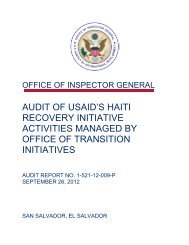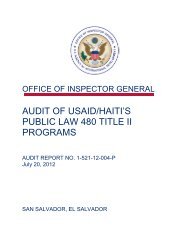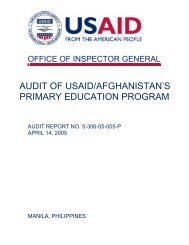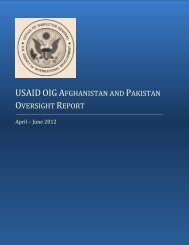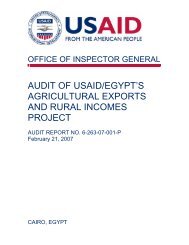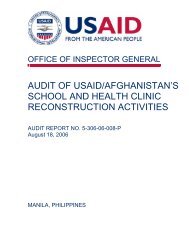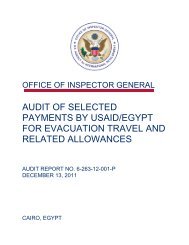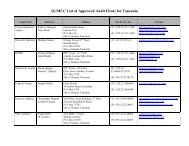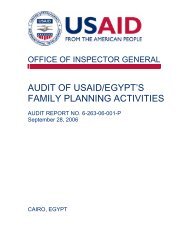PDF Version - US Agency For International Development - Office of ...
PDF Version - US Agency For International Development - Office of ...
PDF Version - US Agency For International Development - Office of ...
Create successful ePaper yourself
Turn your PDF publications into a flip-book with our unique Google optimized e-Paper software.
I. BACKGROUNDSTANDARD STATEMENT OF WORKFOR FINANCIAL AUDITS OF NON-U.S. ORGANIZATIONSCONTRACTED BY THE RECIPIENTOBJECTIVES AND GENERAL STATEMENT OF WORKAUDIT OF <strong>US</strong>AID RESOURCESMANAGED BY [NAME OF RECIPIENT]On [date], the U.S. <strong>Agency</strong> for <strong>International</strong> <strong>Development</strong> (<strong>US</strong>AID), mission to [Country](mission) approved the [program name and number] (program), which provided [amountin U.S. Dollars] in [loan/grant] funds to [name <strong>of</strong> recipient] (recipient) for [describe ingeneral terms the purposes <strong>of</strong> the program and the principal line items and amountsbudgeted, including cost sharing contributions, direct payments and all related financialinformation <strong>of</strong> the program, as applicable].[If recipient activities are financed by more than one program or <strong>of</strong>fice (such as a<strong>US</strong>AID/Washington Bureau), include a similar paragraph for each program.][Include a brief history <strong>of</strong> the recipient, its principal purposes and goals, location(s) <strong>of</strong>activities to be audited, location(s) <strong>of</strong> accounting records and management.][The purpose <strong>of</strong> including complete data on the recipient and the program(s) involved isto provide the auditor with all necessary information for them to properly estimate theiraudit fees.]II.TITLEAudit <strong>of</strong> the Fund Accountability Statement (or Audit <strong>of</strong> Financial Statements, if the auditincludes an audit <strong>of</strong> the general-purpose financial statements) <strong>of</strong> <strong>US</strong>AID ResourcesManaged by [name <strong>of</strong> recipient] Under Program [program number and name] for theperiod from [date] to [date]. In the case <strong>of</strong> close-out audits, 1 the title must specify that itis a close-out audit, as in: Close-out Audit <strong>of</strong> the <strong>US</strong>AID Resources Managed by [name<strong>of</strong> recipient] Under Program [program number and name] for the period from [date] to[date].III.OBJECTIVESThe objective <strong>of</strong> this engagement is to conduct a financial audit <strong>of</strong> the <strong>US</strong>AID resourcesmanaged by the recipient under program [program number and name] from [date] to[date] in accordance with U.S. Government Auditing Standards issued by the U.S.Government Accountability <strong>Office</strong> and the <strong>US</strong>AID <strong>Office</strong> <strong>of</strong> the Inspector General“Guidelines for Financial Audits Contracted by <strong>For</strong>eign Recipients (Guidelines).”The financial audit must include (1) a specific audit <strong>of</strong> all the recipient’s <strong>US</strong>AID-fundedprograms, and (2) an audit <strong>of</strong> the recipient's general purpose financial statements on anorganization-wide basis (balance sheet, income statement, and cash flow statement) if1 A close-out audit is an audit for an award that expired during the period audited.1
the recipient has been authorized to use provisional indirect costs rates, 2mission specifically requests such an audit.or if theThe fund accountability statement is the basic financial statement to be audited thatpresents the recipient's revenues, costs incurred, cash balance <strong>of</strong> funds provided by<strong>US</strong>AID, and commodities directly procured by <strong>US</strong>AID for the recipient's use. The fundaccountability statement should be reconciled to the <strong>US</strong>AID funds included in thegeneral purpose financial statements by a note to the financial statements or the fundaccountability statement. All currency amounts in the fund accountability statement,cost-sharing schedule, and the report findings, if any, must be stated in U.S. dollars.The auditors should indicate the exchange rate(s) used in the notes to the fundaccountability statement.A. Audit <strong>of</strong> <strong>US</strong>AID FundsA financial audit <strong>of</strong> the funds provided by <strong>US</strong>AID must be performed in accordance withU.S. Government Auditing Standards, or other approved standards where applicable,and accordingly includes such tests <strong>of</strong> the accounting records as deemed necessaryunder the circumstances. The specific objectives <strong>of</strong> the audit <strong>of</strong> the <strong>US</strong>AID funds are to:Express an opinion on whether the fund accountability statement for the <strong>US</strong>AIDfundedprograms presents fairly, in all material respects, revenues received, costsincurred, and commodities directly procured by <strong>US</strong>AID for the period audited inconformity with the terms <strong>of</strong> the agreements and generally accepted accountingprinciples or other comprehensive basis <strong>of</strong> accounting (including the cash receiptsand disbursements basis and modifications <strong>of</strong> the cash basis).Evaluate the recipient's internal control related to the <strong>US</strong>AID-funded programs,assess control risk, and identify significant deficiencies including materialweaknesses. This evaluation should include the internal control related to requiredcost-sharing contributions.Perform tests to determine whether the recipient complied, in all material respects,with agreement terms (including cost sharing/counterpart contributions, if applicable)and applicable laws and regulations related to <strong>US</strong>AID-funded programs. All materialinstances <strong>of</strong> noncompliance and all illegal acts that have occurred or are likely tohave occurred should be identified. Such tests should include the compliancerequirements related to required cost-sharing contributions, if applicable.Perform an audit <strong>of</strong> the indirect cost rate(s) if the recipient has been authorized tocharge indirect costs to <strong>US</strong>AID using provisional rates and <strong>US</strong>AID has not yetnegotiated final rates with the recipient.Determine if the recipient has taken adequate corrective action on prior audit reportrecommendations.2 Where the recipient had been authorized to use provisional indirect cost rates, an audit <strong>of</strong> thegeneral purpose financial statements is needed to ensure that all costs have been correctlyincluded in the indirect cost rate calculation.2
Auditors must design audit steps and procedures in accordance with U.S. GovernmentAuditing Standards, Chapter 4, to provide reasonable assurance <strong>of</strong> detecting situationsor transactions in which fraud or illegal acts have occurred or are likely to have occurred.If such evidence exists, the auditors must contact the <strong>US</strong>AID Regional Inspector General<strong>of</strong>fice in Pretoria (RIG/Pretoria) and should exercise due pr<strong>of</strong>essional care in pursuingindications <strong>of</strong> possible fraud and illegal acts so as not to interfere with potential futureinvestigations or legal proceedings.B. Review <strong>of</strong> Cost-Sharing/Counterpart Contributions ScheduleThe audit should determine whether cost-sharing/counterpart contributions wereprovided and accounted for by the recipient in accordance with the terms <strong>of</strong> theagreements, if applicable. The auditors will review the cost-sharing/counterpartschedule to determine if the schedule is fairly presented in accordance with the basis <strong>of</strong>accounting used by the recipient to prepare the schedule. The auditors should questionall cost-sharing/counterpart contributions that are either ineligible or unsupported costs.In addition, for audits <strong>of</strong> agreements that present a cost-sharing/counterpart contributionbudget on an annual basis and for close-out audits <strong>of</strong> awards that present costsharing/counterpartcontribution budgets on a life-<strong>of</strong>-project basis, the auditors willreview the cost-sharing/counterpart contributions schedule to determine if costsharing/counterpartcontributions were provided by the recipient in accordance with theterms <strong>of</strong> the agreement.C. Audit <strong>of</strong> General Purpose Financial StatementsA financial audit <strong>of</strong> the recipient's general purpose financial statements on anorganization-wide basis must be submitted to <strong>US</strong>AID together with the audit <strong>of</strong> <strong>US</strong>AIDfunds if the recipient has been authorized to charge indirect costs, or if the missionspecifically requests such an audit. The audit must be performed in accordance withgenerally accepted auditing standards <strong>of</strong> the American Institute <strong>of</strong> Certified PublicAccountants (AICPA), auditing standards that have been prescribed by the laws <strong>of</strong> thecountry or adopted by an association <strong>of</strong> public accountants in the country, or auditingstandards promulgated by the <strong>International</strong> Organization <strong>of</strong> Supreme Audit Institutions or<strong>International</strong> Auditing Practices Committee <strong>of</strong> the <strong>International</strong> Federation <strong>of</strong>Accountants. The objective <strong>of</strong> this audit is to express an opinion on whether thosestatements present fairly, in all material respects, the recipient’s financial position atyear-end, and the results <strong>of</strong> its operations and cash flows for the year then ended, inconformity with generally accepted accounting principles.IV.AUDIT SCOPEThe auditor should use the following steps as the basis for preparing audit programs.They are not all-inclusive or restrictive in nature and do not relieve the auditor fromexercising due pr<strong>of</strong>essional care and judgment. The steps should be modified to fit localconditions and specific program design, implementation procedures, and agreementprovisions which may vary from program to program. Any limitations in the scope <strong>of</strong>work must be communicated as soon as possible to RIG/Pretoria.3
A. Pre-Audit StepsFollowing is a list <strong>of</strong> documents applicable to different <strong>US</strong>AID programs. The auditorshould review the applicable documents considered necessary to perform the audit:1. The agreement between <strong>US</strong>AID and the recipient.2. The subagreements between the recipient and other implementing entities, asapplicable.3. Contracts and subcontracts with third parties, if any.4. The budgets, implementation letters, and written procedures approved by <strong>US</strong>AID.5. <strong>US</strong>AID Automated Directives System Chapter 636 – “Program Funded Advances”6. OMB Circular A-122 "Cost Principles for Nonpr<strong>of</strong>it Organizations" (2 CFR Part 230).7. OMB Circular A-21 "Cost Principles for Educational Institutions" (2 CFR Part 220).8. Federal Acquisition Regulation (FAR), Part 31, Contract Cost Principles andProcedures.9. <strong>US</strong>AID Acquisition Regulation (AIDAR), which supplement the FAR.10. Mandatory Standard Provisions for Non-U.S. Nongovernmental Grantees (<strong>US</strong>AIDAutomated Directives System, Chapter 303 Internal Mandatory References).11. Standard Provisions Annex for Agreements with <strong>For</strong>eign Governments (<strong>US</strong>AIDAutomated Directives System, Chapter 350).12. All program financial and progress reports; and charts <strong>of</strong> accounts, organizationalcharts; accounting systems descriptions; procurement policies and procedures; andreceipt, warehousing and distribution procedures for materials, as necessary tosuccessfully complete the required work.13. Any previous audits, financial reviews, etc., that directly relate to the objectives <strong>of</strong> theaudit.B. Fund Accountability StatementThe auditor must examine the fund accountability statement 3 for <strong>US</strong>AID programsincluding the budgeted amounts by category and major items; the revenues receivedfrom <strong>US</strong>AID for the period covered by the audit; the costs reported by the recipient asincurred during that period; and the commodities directly procured by <strong>US</strong>AID for the3 A “fund accountability statement” is a financial statement that presents a <strong>US</strong>AID recipient’srevenues, costs incurred, cash balances <strong>of</strong> funds (after considering reconciling items), andcommodities directly procured by <strong>US</strong>AID that were provided by <strong>US</strong>AID agreements. The fundaccountability statement must be presented in U.S. dollars and the exchange rate(s) used mustbe disclosed in a note to the fund accountability statement.4
ecipient's use. The fund accountability statement must include all <strong>US</strong>AID assistancefunds identified by each specific program or agreement. The revenues received from<strong>US</strong>AID less the costs incurred, after considering any reconciling items, must reconcilewith the balance <strong>of</strong> cash-on-hand or in bank accounts. 4 The fund accountabilitystatement should not include cost-sharing/counterpart contributions provided from therecipient's own funds or in-kind. However, a separate cost sharing/counterpartcontributions schedule must be included and reviewed to determine whether costsharing/counterpart contributions were provided and accounted for in accordance withthe terms <strong>of</strong> the agreement (see section IV.C. <strong>of</strong> this statement <strong>of</strong> work).The auditors may prepare or assist the recipient in the preparing the fund accountabilitystatement from the books and records maintained by the recipient, but the recipient mustaccept the responsibility for the statement’s accuracy before the audit commences.The opinion on the fund accountability statement must comply with Statement onAuditing Standard (SAS) No. 62 (AU623). The fund accountability statement mustseparately identify those revenues and costs applicable to each specific <strong>US</strong>AIDagreement. The audit must evaluate program implementation actions andaccomplishments to determine whether specific costs incurred are allowable, allocable,and reasonable under the agreement terms and applicable cost principles, and toidentify areas where fraud and illegal acts have occurred or are likely to have occurredas a result <strong>of</strong> inadequate internal control. At a minimum, the auditors must:1. Review direct and indirect costs billed to and reimbursed by <strong>US</strong>AID and costsincurred but pending reimbursement by <strong>US</strong>AID, identifying and quantifying anyquestioned costs. All costs that are not supported with adequate documentation orare not in accordance with the agreement terms must be reported as questioned.Questioned costs that are pending reimbursement by <strong>US</strong>AID must be identified inthe notes to the fund accountability statement as not reimbursed by <strong>US</strong>AID.a. Questioned costs must be presented in the fund accountability statement in twoseparate categories. Ineligible costs that are explicitly questioned because theyare unreasonable, prohibited by the agreements or applicable laws andregulations, or not program related. In addition, if a recipient was required toplace <strong>US</strong>AID funds in an interest-bearing account but did not, then the imputedinterest that would have been earned is also classified as an ineligible cost.Unsupported costs are not supported with adequate documentation or did nothave required prior approvals or authorizations. All material questioned costsresulting from instances <strong>of</strong> noncompliance with agreement terms and applicablelaws and regulations must be included as findings in the report on compliance.Also, the notes to the fund accountability statement must briefly describe bothmaterial and immaterial questioned costs and must be cross-referenced to anycorresponding findings in the report on compliance.2. Review general and program ledgers to determine whether costs incurred wereproperly recorded. Reconcile direct costs billed to, and reimbursed by, <strong>US</strong>AID to theprogram and general ledgers.4 If the recipient does not receive any advances from <strong>US</strong>AID, i.e., it operates on a reimbursementbasis, then the recipient will not hold any balances <strong>of</strong> <strong>US</strong>AID funds.5
3. Review procedures used to control the funds, including their channeling tocontracted financial institutions or other implementing entities. Review bankaccounts and the controls on those bank accounts. Perform positive confirmation <strong>of</strong>balances, as necessary.4. Determine whether advances <strong>of</strong> funds were justified with documentation, includingreconciliations <strong>of</strong> funds advanced, disbursed, and available. The auditors mustensure that all funding received by the recipient from <strong>US</strong>AID was appropriatelyrecorded in the recipient's accounting records and that those records wereperiodically reconciled with information provided by <strong>US</strong>AID.5. Determine whether program income was added to funds used to further eligibleproject or program objectives, to finance the non-federal share <strong>of</strong> the project orprogram, or deducted from program costs, in accordance with <strong>US</strong>AID regulations,other implementing guidance, or the terms and conditions <strong>of</strong> the award.6. Review procurement procedures to determine whether sound commercial practicesincluding competition were used, reasonable prices were obtained, and adequatecontrols were in place over the qualities and quantities received.7. Review direct salary charges to determine whether salary rates were reasonable forthat position, in accordance with those approved by <strong>US</strong>AID when <strong>US</strong>AID approval isrequired, and supported by appropriate payroll records. Determine if overtime wascharged to the program and whether it was allowable under the terms <strong>of</strong> theagreements. Determine whether allowances and fringe benefits received byemployees were in accordance with the agreements and applicable laws andregulations. The auditors should question unallowable salary charges in the fundaccountability statement.8. Review travel and transportation charges to determine whether they were adequatelysupported and approved. Travel charges that are not supported with adequatedocumentation or not in accordance with agreements and regulations must bequestioned in the fund accountability statement.9. Review commodities (e.g., supplies, materials, vehicles, equipment, food products,tools, etc.) procured by the recipient or directly procured by <strong>US</strong>AID for the recipient'suse. The auditors should determine whether commodities exist or were used fortheir intended purposes in accordance with the terms <strong>of</strong> the agreements, andwhether control procedures exist and have been placed in operation to adequatelysafeguard the commodities. As part <strong>of</strong> the procedures to determine if commoditieswere used for intended purposes, the auditors should perform end-use reviews foran appropriate sample <strong>of</strong> all commodities based on the control risk assessment (seesection IV.D. <strong>of</strong> this statement <strong>of</strong> work). End-use reviews may include site visits toverify that commodities exist or were used for their intended purposes in accordancewith the terms <strong>of</strong> the agreements. The cost <strong>of</strong> all commodities whose existence orproper use in accordance with the terms <strong>of</strong> the agreements cannot be verified mustbe questioned in the fund accountability statement. (The auditor should determinethe cost <strong>of</strong> commodities based on supporting documentation available from therecipient or <strong>US</strong>AID, as appropriate.)6
10. Review technical assistance and services procured by the recipient. The auditorsshould determine whether technical assistance and services were used for theirintended purposes in accordance with the terms <strong>of</strong> the agreements. The cost <strong>of</strong>technical assistance and services not properly used in accordance with the terms <strong>of</strong>the agreements must be questioned in the fund accountability statement.a. In addition to the above audit procedures, if technical assistance and serviceswere contracted by the recipient from a non-U.S. contractor, the auditors shouldperform additional audit steps on the technical assistance and services, unlessthe recipient has separately contracted for an audit <strong>of</strong> these costs. When testingfor compliance with agreement terms and applicable laws and regulations, theauditors should not only consider agreements between the recipient and <strong>US</strong>AID,but also agreements between the recipient and non-U.S. contractors providingtechnical assistance and services. The agreements between the recipient andthe non-U.S. contractors should be audited using the same audit steps describedin the other paragraphs <strong>of</strong> this section, including all tests necessary to specificallydetermine that costs incurred are allowable, allocable, reasonable, andsupported under the agreement terms.b. If the technical assistance and services were contracted by the recipient from aU.S. contractor, the auditors are still responsible for determining whethertechnical assistance and services were used for their intended purposes inaccordance with the terms <strong>of</strong> the agreements. However, the auditors are notresponsible for performing additional audit steps for the costs incurred under thetechnical assistance and services agreements, since either <strong>US</strong>AID or a cognizantU.S. Government agency is responsible for contracting for audits <strong>of</strong> these costs.11. When indirect costs are charged to <strong>US</strong>AID using provisional rates, review theallocation method to determine that the indirect cost pool and distribution baseinclude only allowable items in accordance with the agreement terms andregulations. The auditors should be aware that costs that are unallowable ascharges to <strong>US</strong>AID agreements (e.g., fundraising) must be allocated their share <strong>of</strong>indirect costs if they represent activities that (1) include the salaries <strong>of</strong> personnel, (2)occupy space, and (3) benefit from the organization’s indirect costs. Indirect costrates must be calculated after all adjustments have been made to the pool and base.When indirect costs are charged to <strong>US</strong>AID using predetermined or fixed rates, verifythat the correct rates are applied in accordance with the agreement with <strong>US</strong>AID.12. Review unliquidated advances to the recipient and pending reimbursements by<strong>US</strong>AID when performing final closeout audits. Ensure that the recipient has returnedany excess cash to <strong>US</strong>AID. Also, ensure that all assets (inventories, fixed assets,commodities, etc.) procured with program funds were disposed <strong>of</strong> in accordance withthe terms <strong>of</strong> the agreements. The auditors should present, as an annex to the fundaccountability statement, the balances and details <strong>of</strong> final inventories <strong>of</strong>nonexpendable property acquired under the agreements. This inventory shouldindicate which items were titled to the U.S. Government and which were titled toother entities. These closeout audit procedures must be performed for any awardthat expires during the period audited.The fund accountability statement included as Example 6.1 <strong>of</strong> the Guidelines illustrateshow to report the results <strong>of</strong> a single audit that covers more than one <strong>US</strong>AID agreement.7
In such cases, the fund accountability statement must separately disclose the financialinformation (revenues, costs, etc.) for each agreement, and must identify the <strong>US</strong>AIDmissions/<strong>of</strong>fices that provided funding for each agreement. Questioned costs, andinternal control and compliance findings <strong>of</strong> any audits <strong>of</strong> subrecipients must be reportedin the recipient’s financial audit using the same treatment and procedures as therecipient’s own questioned costs and findings. This is particularly important in audits <strong>of</strong>recipients covering agreements from more than one <strong>US</strong>AID mission. Each mission canidentify its agreements in the audit report for resolution <strong>of</strong> findings and recommendationswith the recipient. The same reporting principles apply when only one <strong>US</strong>AIDagreement is covered by the audit.The auditors must generally express a single opinion on the fund accountabilitystatement that includes more than one agreement with <strong>US</strong>AID. Auditors must notexpress separate opinions on fund accountability statements <strong>of</strong> each agreement orprogram unless specifically requested to do so by the <strong>US</strong>AID mission.C. Cost Sharing/Counterpart Contribution Schedule<strong>US</strong>AID agreements may require contributions by the recipient. Most agreementsestablish a life-<strong>of</strong>-project budget for such contributions; however, some agreements mayestablish annual budgets for those contributions. The review <strong>of</strong> the cost sharingschedule must be approached differently depending on whether the costsharing/counterpart contribution budget is a life-<strong>of</strong> project budget or an annual budget.In either case, the review consists principally <strong>of</strong> inquiries <strong>of</strong> recipient personnel andanalytical procedures applied to financial data supporting the cost sharing/counterpartcontributions schedule.The auditors may prepare or assist the recipient in preparing the costsharing/counterpart contributions schedule from the books and records maintained bythe recipient. The recipient must, however, accept responsibility for the schedule'saccuracy before the review commences.C.1.Agreement with Life-<strong>of</strong>-Project Cost Sharing/Counterpart ContributionBudget<strong>For</strong> an agreement with a life-<strong>of</strong>-project budget for cost-sharing/counterpart contributions,it is not possible to determine whether the contributions have been made as requireduntil the agreement ends. Nonetheless, <strong>US</strong>AID and the recipient need reliableinformation to monitor actual cost-sharing/counterpart contributions throughout the life <strong>of</strong>the agreement.Thus, for agreements with a life-<strong>of</strong>-project budget for cost-sharing/counterpartcontributions, for each year that an audit is performed in accordance with the Guidelines,the auditors will review the cost sharing/counterpart contributions schedule to determineif the schedule is fairly presented in accordance with the basis <strong>of</strong> accounting used by therecipient to prepare the schedule. The auditors must question all costsharing/counterpartcontributions that are either ineligible or unsupported costs. Anineligible cost is unreasonable, prohibited by the agreements or applicable laws andregulations, or not program related. An unsupported cost lacks adequate documentationor does not have required prior approvals or authorizations. All questioned costs mustbe briefly described in the notes to the cost sharing/counterpart contributions schedule.8
In addition, material questioned costs must be included as findings in the report oncompliance. Notes to the cost sharing/counterpart contributions schedule must becross-referenced to the corresponding findings in the report on compliance. Also,significant deficiencies in internal control related to cost-sharing/counterpartcontributions must be set forth as findings in the report on internal control. (See samplecost sharing/counterpart contributions schedule at Example 6.2.A, and sample reports atExamples 7.6.A and 7.6.B <strong>of</strong> the Guidelines.)In addition, for closeout audits <strong>of</strong> agreements with a life-<strong>of</strong>-project budget for costsharing/counterpartcontributions, the auditors will review the cost-sharing/counterpartcontributions schedule to determine if the recipients provided such contributions inaccordance with the terms <strong>of</strong> the agreement. If actual contributions were less thanbudgeted contributions, the shortfall will be identified in the appropriate column <strong>of</strong> thecost sharing/counterpart contributions schedule. (See sample cost sharing/counterpartcontributions schedule at Example 6.2.B, and sample reports at Examples 7.6.C and7.6.D <strong>of</strong> the Guidelines.)C.2.Agreement with Annual Cost Sharing/Counterpart Contributions Budget<strong>For</strong> agreements with an annual budget for cost sharing/counterpart contributions, foreach year that an audit is performed in accordance with the Guidelines, the auditors willreview the cost sharing/counterpart contributions schedule to determine whether (1) theschedule is fairly presented in accordance with the basis <strong>of</strong> accounting used by therecipient to prepare the cost sharing/counterpart contributions schedule and (2)contributions were provided by the recipient in accordance with the terms <strong>of</strong> theagreement. The auditors must question all cost sharing/counterpart contributions thatare either ineligible or unsupported costs. An ineligible cost is unreasonable, prohibitedby the agreements or applicable laws and regulations, or not program related. Anunsupported cost lacks adequate documentation or does not have required priorapprovals or authorizations. All questioned costs must be briefly described in the notesto the cost sharing/counterpart contributions schedule. In addition, material questionedcosts must be included as findings in the report on compliance. Notes to the costsharing/counterpart contributions schedule must be cross-referenced to thecorresponding findings in the report on compliance. Also, significant deficiencies ininternal control related to cost sharing/counterpart contributions must be set forth asfindings in the report on internal control. If actual cost sharing/counterpart contributionswere less than budgeted contributions, the shortfall will be identified in the appropriatecolumn <strong>of</strong> the cost sharing/counterpart contributions schedule. (See sample costsharing/counterpart contributions schedule at Example 6.2.B, and sample reports atExamples 7.6.C and 7.6.D <strong>of</strong> the Guidelines.)D. Internal ControlsThe auditors must obtain a sufficient understanding <strong>of</strong> the entity and its environment,including its internal control, to assess the risk <strong>of</strong> material misstatement <strong>of</strong> the financialstatements whether due to error or fraud, and to design the nature, timing, and extent <strong>of</strong>further audit procedures. In obtaining this understanding, the auditor must understandthe design <strong>of</strong> the internal control related to <strong>US</strong>AID programs and determine whether theyhave been placed in operation. The U.S. General Accounting <strong>Office</strong>'s Standards forInternal Controls in the Federal Government (GAO/AIMD-00-21.3.1; 1999) may be9
helpful in assessing recipient internal controls. The internal control must be described inthe audit documentation.Auditors must then prepare the report required by the Guidelines, identifying anysignificant deficiencies or material weaknesses in the design or operation <strong>of</strong> internalcontrol. A material weakness is a deficiency, or combination <strong>of</strong> deficiencies, in internalcontrol, such that there is a reasonable possibility that a material misstatement <strong>of</strong> theentity’s financial statements will not be prevented or detected and corrected on a timelybasis. A significant deficiency is a deficiency, or combination <strong>of</strong> deficiencies, in internalcontrol that is less severe that a material weakness that is important enough to meritattention by those charged with governance. Any significant deficiencies or materialweaknesses must be set forth in the report as “findings” (see paragraph 5.1.d <strong>of</strong> theGuidelines). Any other matters related to internal control – such as suggestions forimproving operational or administrative efficiency or internal control, or controldeficiencies that are not significant deficiencies or material weaknesses – may bereported in a separate management letter to the recipient and referred to in the report oninternal control.The major internal control components to be studied and evaluated include, but are notlimited to, the controls related to each revenue and expense account on the fundaccountability statement. The auditors must:1. Obtain an understanding <strong>of</strong> the design <strong>of</strong> the internal control related to <strong>US</strong>AIDprograms and determine whether they have been placed in operation.2. Assess inherent risk and control risk, and determine the detection risk. Inherent riskis the susceptibility <strong>of</strong> an assertion, such as an account balance, to a misstatementthat could be material, either individually or when aggregated with othermisstatements, assuming that there are no related controls. Control risk is the riskthat a misstatement that could occur in a relevant assertion and that could bematerial, either individually or when aggregated with other misstatements, will not beprevented or detected on a timely basis by the entity's internal control. Detection riskis the risk that the auditor will not detect a material misstatement that exists in anassertion. Detection risk is based upon the effectiveness <strong>of</strong> an auditing procedureand the auditor’s application <strong>of</strong> that procedure.3. Summarize the risk assessments for each assertion in a single document included inthe audit documentation. The risk assessments should consider the following broadcategories under which each assertion should be classified: (a) classes <strong>of</strong>transactions and events for the period under audit (occurrence, completeness,accuracy, cut<strong>of</strong>f, and classification), (b) account balances at the period end(existence, rights, obligations, completeness, valuation, and allocation), and (c)presentation and disclosure (occurrence, rights, obligations, completeness,classification, understandability, accuracy, and valuation). At a minimum, the auditdocumentation should identify the name <strong>of</strong> the account or assertion, the accountbalance or the amount represented by the assertion, the assessed level <strong>of</strong> inherentrisk (high, moderate, or low), the assessed level <strong>of</strong> control risk (high, moderate, orlow), the combined risk (high, moderate, or low), and a description <strong>of</strong> the nature,timing and extent <strong>of</strong> the tests performed based on the combined risk. Summaryaudit documentation should be cross-indexed to supporting audit documentation thatcontains the detailed analysis <strong>of</strong> the fieldwork. If control risk is evaluated at less than10
the maximum level (high), then the basis for the auditor’s conclusion must bedescribed in the audit documentation.a. If the auditors assess control risk at the maximum level for assertions related tomaterial account balances, transaction classes, and disclosure components <strong>of</strong>financial statements when such assertions are significantly dependent uponcomputerized information systems, the auditors must describe in the auditdocumentation the basis for such conclusions by addressing (i) theineffectiveness <strong>of</strong> the design and/or operation <strong>of</strong> controls, or (ii) the reasons whyit would be inefficient to test the controls.4. Evaluate the control environment, the adequacy <strong>of</strong> the accounting systems, andcontrol procedures. Emphasize the policies and procedures that pertain to therecipient’s ability to record, process, summarize, and report financial data consistentwith the assertions embodied in each account <strong>of</strong> the fund accountability statement.This should include, but not be limited to, the control systems for:a. Ensuring that charges to the program are proper and supported.b. Managing cash on hand and in bank accounts.c. Procuring goods and services.d. Managing inventory and receiving functions.e. Managing personnel functions such as timekeeping, salaries, and benefits.f. Managing and disposing <strong>of</strong> commodities (such as supplies, materials, vehicles,equipment, food products, tools, etc.) purchased either by the recipients ordirectly by <strong>US</strong>AID.g. Ensuring compliance with agreement terms and applicable laws and regulationsthat collectively have a material impact on the fund accountability statement. Theresults <strong>of</strong> this evaluation must be contained in the audit documentation sectiondescribed in Section IV.E. <strong>of</strong> this statement <strong>of</strong> work and presented in thecompliance report.5. Evaluate internal control established to ensure compliance with costsharing/counterpart contribution requirements, if applicable, including both provisionand management <strong>of</strong> the contributions.6. Include in the study and evaluation other policies and procedures that may berelevant if they pertain to data the auditors use in applying auditing procedures. Thismay include, for example, policies and procedures that pertain to nonfinancial datathat the auditor uses in analytical procedures.In fulfilling the audit requirement relating to an understanding <strong>of</strong> the internal control andassessing the level <strong>of</strong> control risk, the auditor must follow, at a minimum, the guidancecontained in AICPA SAS Nos. 109 (AU314), entitled Understanding the Entity and ItsEnvironment and Assessing the Risks <strong>of</strong> Material Misstatements, 115 (AU325), entitled11
Communicating Internal Control Related Matters Identified in an Audit, and 117 (AU801)entitled Compliance Audits.E. Compliance with Agreement Terms and Applicable Laws and RegulationsIn fulfilling the audit requirement to determine compliance with agreement terms andapplicable laws and regulations related to <strong>US</strong>AID programs, the auditors must, at aminimum, follow guidance contained in AICPA SAS No. 117 (AU801) entitledCompliance Audits. The compliance review must also determine – on audits <strong>of</strong> awardsthat present cost sharing/counterpart contribution budgets on an annual basis and onclose-out audits <strong>of</strong> awards that present cost sharing/counterpart contribution budgets ona life-<strong>of</strong>-project basis – if cost sharing/counterpart contributions were provided andaccounted for in accordance with the terms <strong>of</strong> the agreements. The auditor's report oncompliance must set forth as findings all material instances <strong>of</strong> noncompliance, definedas instances that could have a direct and material effect on the fund accountabilitystatement. Nonmaterial instances <strong>of</strong> noncompliance must be included in a separatemanagement letter to the recipient and referred to in the report on compliance.The auditor's report should include all conclusions that a fraud or illegal act either hasoccurred or is likely to have occurred. In reporting material fraud, illegal acts, or othernoncompliance, the auditors should place their findings in proper perspective. To givethe reader a basis for judging the prevalence and consequences <strong>of</strong> these conditions, theinstances identified should be related to the universe or the number <strong>of</strong> cases examinedand is quantified in terms <strong>of</strong> U.S. dollars, if appropriate. In presenting material fraud,illegal acts, or other noncompliance, auditors must follow the reporting standardscontained in Chapter 5 <strong>of</strong> U.S. Government Auditing Standards. Chapter 4 <strong>of</strong> U.S.Government Auditing Standards discusses factors that may influence auditors’materiality judgments. If the auditors conclude that sufficient evidence <strong>of</strong> fraud or illegalacts exists, they must contact RIG/Pretoria and exercise due pr<strong>of</strong>essional care inpursuing indications <strong>of</strong> possible fraud and illegal acts to avoid interfering with potentialfuture investigations or legal proceedings.In planning and conducting the tests <strong>of</strong> compliance, the auditors must:1. Identify the agreement terms and pertinent laws and regulations and determinewhich <strong>of</strong> those, if not observed, could have a direct and material effect on the fundaccountability statement. The auditors must:a. List all standard and program-specific provisions contained in the agreementsthat cumulatively, if not observed, could have a direct and material effect on thefund accountability statement.b. Assess the inherent and control risk that material noncompliance could occur foreach <strong>of</strong> the compliance requirements listed in 1.a above.c. Determine the nature, timing and extent <strong>of</strong> audit steps and procedures to test forerrors, fraud, and illegal acts that provide reasonable assurance <strong>of</strong> detecting bothintentional and unintentional instances <strong>of</strong> noncompliance with agreement termsand applicable laws and regulations that could have a material effect on the fundaccountability statement. This should be based on the risk assessment in 1.babove.12
d. Prepare a single summary document in the audit documentation that identifieseach <strong>of</strong> the specific compliance requirements included in the review, the results<strong>of</strong> the inherent, control and (detection) risk assessments for each compliancerequirement, the audit steps used to test for compliance with each <strong>of</strong> therequirements based on the risk assessment, and the results <strong>of</strong> the compliancetesting for each requirement. The summary document should be cross-indexedto detailed audit documentation that support the facts and conclusions containedin the summary document.2. Determine if payments have been made in accordance with agreement terms andapplicable laws and regulations.3. Determine if funds have been expended for purposes not authorized or not inaccordance with applicable agreement terms. If so, the auditors must question thesecosts in the fund accountability statement.4. Identify any costs not considered appropriate, classifying and explaining why thesecosts are questioned.5. Determine whether commodities, whether procured by the recipient or directlyprocured by <strong>US</strong>AID for the recipient’s use, exist or were used for their intendedpurposes in accordance with the terms <strong>of</strong> the agreements. If not, the cost <strong>of</strong> suchcommodities must be questioned.6. Determine whether any technical assistance and services procured by the recipientwere used for their intended purposes in accordance with the agreements. If not, thecost <strong>of</strong> such technical assistance and services should be questioned.7. Determine if the amount <strong>of</strong> cost sharing/counterpart contribution funds wascalculated and accounted for as required by the agreements or applicable costprinciples.8. Determine if the cost sharing/counterpart contribution funds 5 were providedaccording to the terms <strong>of</strong> the agreements and quantify any shortfalls.9. Determine whether those who received services and benefits were eligible to receivethem.10. Determine whether the recipient's financial reports (including those on the status <strong>of</strong>cost sharing/counterpart contributions) and claims for advances and reimbursementcontain information that is supported by the books and records.11. Determine whether the recipient held advances <strong>of</strong> <strong>US</strong>AID funds in interest-bearingaccounts, and whether the recipient remitted to <strong>US</strong>AID any interest earned on thoseadvances, with the exception <strong>of</strong> up to $250 a year that the recipient may retain for5 This step is applicable on audits <strong>of</strong> awards that present cost sharing/counterpart contributionsbudgets on an annual basis and for closeout audits <strong>of</strong> awards that present costsharing/counterpart contribution budgets on a life-<strong>of</strong>-project basis, as explained in paragraphs4.12 and 4.13 <strong>of</strong> the Guidelines.13
administrative expenses. If the recipient was required to place <strong>US</strong>AID funds in aninterest-bearing bank account but did not, then the auditor should determine theamount <strong>of</strong> interest that was foregone by the recipient, and this amount should beclassified as ineligible costs.F. Follow-Up on Prior Audit RecommendationsThe auditors must review the status <strong>of</strong> actions taken on findings and recommendationsreported in prior audits <strong>of</strong> <strong>US</strong>AID-funded programs. Paragraph 4.09 <strong>of</strong> the U.S.Government Auditing Standards states: "Auditors should evaluate whether the auditedentity has taken appropriate corrective action to address findings and recommendationsfrom previous engagements that could have a material effect on the financialstatements. When planning the audit, auditors should ask management <strong>of</strong> the auditedentity to identify previous audits, attestation engagements, financial reviews, and otherstudies that directly relate to the objectives <strong>of</strong> the audit, including whether relatedrecommendations have been implemented. Auditors should use this information inassessing risk and determining the nature, timing, and extent <strong>of</strong> current audit work,including determining the extent to which testing the implementation <strong>of</strong> the correctiveactions is applicable to the current audit objectives.”The auditors must describe the scope <strong>of</strong> their work on prior audit recommendations inthe summary section <strong>of</strong> the audit report. The auditors should refer to the most recentrecipient or agency contracted audit report for the same award (for a follow-up audit) orother <strong>US</strong>AID awards (for an initial audit). When corrective action has not been takenand the deficiency remains unresolved for the current audit period the auditors need tobriefly describe the prior finding and status and show the page reference to where it isincluded in the current report. If there were no prior findings and recommendations, theauditors must include a note to that effect in this section <strong>of</strong> the audit report.G. General Purpose Financial StatementsAuditors should examine the recipient’s general purpose financial statements on anorganization-wide basis if an indirect cost rate needs to be audited, 6 or if the missionspecifically requests that the general purpose financial statements be audited. The auditmust be performed in accordance with generally accepted auditing standards <strong>of</strong> theAmerican Institute <strong>of</strong> Certified Public Accountants (AICPA), auditing standards that havebeen prescribed by the laws <strong>of</strong> the country or adopted by an association <strong>of</strong> publicaccountants in the country, or auditing standards promulgated by the <strong>International</strong>Organization <strong>of</strong> Supreme Audit Institutions or <strong>International</strong> Auditing Practices Committee<strong>of</strong> the <strong>International</strong> Federation <strong>of</strong> Accountants.The objective <strong>of</strong> this audit is to express an opinion on whether those statements presentfairly, in all material respects, the recipient's financial position at year-end, and theresults <strong>of</strong> its operations and cash flow for the year then ended, in conformity withgenerally accepted accounting principles.6 Where indirect costs are authorized, an audit <strong>of</strong> the general purpose financial statements isneeded to ensure that all costs have been correctly included in the indirect cost rate calculation.14
H. Indirect Cost RatesThe auditors should determine the actual indirect cost rates for the year if the recipienthas used provisional rates to charge indirect costs to <strong>US</strong>AID. The audit <strong>of</strong> the indirectcost rates should include tests to determine whether the:1. Distribution or allocation base includes all costs that benefited from indirect activities.2. Distribution or allocation base is in compliance with the governing <strong>US</strong>AID NegotiatedIndirect Cost Rate Agreement (NICRA), if applicable.3. Indirect cost pool includes only costs authorized by the <strong>US</strong>AID agreements andapplicable cost principles.4. Indirect cost rates obtained by dividing the indirect cost pool by the base areaccurately calculated.5. Costs included in this calculation reconcile with the total expenses shown in therecipient’s audited general purpose financial statements.The results <strong>of</strong> the audit <strong>of</strong> the indirect cost rate must be presented in a schedule <strong>of</strong>computation <strong>of</strong> indirect cost rate (see Example 6.3 the Guidelines). This scheduleshould contain: (1) a listing <strong>of</strong> costs included in each indirect cost pool, (2) thedistribution base, and (3) the calculation and the resultant indirect cost rate calculation.The costs in the schedule should reconcile with the total expenses shown in therecipient’s general purpose financial statements. U.S. <strong>Office</strong> <strong>of</strong> Management andBudget (OMB) Circular A-122 (2 CFR Part 230) provides additional guidance onallocation <strong>of</strong> indirect costs and determination <strong>of</strong> indirect cost rates.I. Other Audit ResponsibilitiesThe auditors must perform the following steps:1. Hold entrance and exit conferences with the recipient. The cognizant <strong>US</strong>AID missionand RIG/Pretoria should be notified <strong>of</strong> these conferences in order that <strong>US</strong>AIDrepresentatives may attend, if deemed necessary.2. During the planning stages <strong>of</strong> an audit, communicate information to the auditeeregarding the nature and extent <strong>of</strong> planned testing and reporting on compliance withlaws and regulations and internal control over financial reporting. 7 Suchcommunication should state that the auditors do not plan to provide opinions oncompliance with laws and regulations and internal control over financial reporting.This communication should be in the form <strong>of</strong> an engagement letter.3. Institute quality control procedures to ensure that sufficient appropriate evidence isobtained through inspection, observation, inquiries, and confirmations to afford areasonable basis for an opinion regarding the financial statements under audit.7 The auditors only express an opinion on the fund accountability statement, the indirect cost rate,and general purpose financial statements, if applicable, as indicated on Chapter 3 <strong>of</strong> theGuidelines.15
While auditors may use their standard procedures for ensuring quality control, thoseprocedures must, at a minimum, ensure that:a. Audit reports and audit documentation are reviewed by an auditor, preferably atthe partner level, who was not involved in the audit. This review must bedocumented.b. All quantities and monetary amounts involving calculations are footed and crossfooted.c. All factual statements, numbers, conclusions and monetary amounts are crossindexedto supporting audit documentation.4. The auditor must ascertain, before preparing its proposal for the audit engagement(or if this is not possible, at the earliest opportunity during the engagement itself),whether the recipient ensured that audits <strong>of</strong> its subrecipients were performed toensure accountability for <strong>US</strong>AID funds passed through to subrecipients (seeparagraph 1.6 <strong>of</strong> the Guidelines). If subrecipient audit requirements were not met,the auditors should immediately notify the cognizant <strong>US</strong>AID mission andRIG/Pretoria and consider whether they can audit the subrecipient costs themselves.If, after consultation with the cognizant <strong>US</strong>AID mission and RIG/Pretoria, the auditorsconclude that a restriction on the scope <strong>of</strong> the audit exists and the restriction cannotbe removed, then the auditors should consider modifying their opinion and any coststhat have not been audited as required must be questioned as unsupported costs.5. Obtain a management representation letter in accordance with AICPA SAS No. 85(AU333) signed by the recipient's management. See Example 4.1 <strong>of</strong> the Guidelinesfor an illustrative management representation letter.V. AUDIT REPORTSThe recipient should submit to the cognizant <strong>US</strong>AID mission a portable document format(<strong>PDF</strong>) copy <strong>of</strong> the audit report in English and a <strong>PDF</strong> copy <strong>of</strong> the report in the recipientcountry’s <strong>of</strong>ficial language, if considered appropriate. The <strong>US</strong>AID mission will forwardthe report to RIG/Pretoria for processing. The format and content <strong>of</strong> the audit reportsshould closely follow the illustrative reports in Chapter 7 <strong>of</strong> the Guidelines. The auditreport must specify the correct award number(s) <strong>of</strong> each award covered by the audit.The report must contain:A. A title page, 8 table <strong>of</strong> contents, transmittal letter, and summary which includes: (1) abackground section with a general description <strong>of</strong> the <strong>US</strong>AID programs audited, theperiod covered, the program objectives, a clear identification <strong>of</strong> all entities mentionedin the report, a section on the follow-up <strong>of</strong> prior audit recommendations, and whethercost sharing/counterpart contributions were required during the period audited, andwhether the recipient has a <strong>US</strong>AID-authorized provisional indirect cost rate; (2) theobjectives and scope <strong>of</strong> the financial audit, and a clear explanation <strong>of</strong> the proceduresperformed and the scope limitations, if any; (3) a brief summary <strong>of</strong> the audit resultson the fund accountability statement, questionable costs, internal control, compliance8 “Closeout” audits must specify that are closeout audits on the title page. A closeout audit is anaudit for an award that expired during the period audited.16
with agreement terms and applicable laws and regulations, indirect cost rates, status<strong>of</strong> prior audit recommendations, and, if applicable, the recipient's general purposefinancial statements on an organization-wide basis; (4) a brief summary <strong>of</strong> the results<strong>of</strong> the review <strong>of</strong> cost sharing/counterpart contributions; and (5) a brief summary <strong>of</strong>the recipient's management comments regarding their views on the audit and reviewresults and findings.B. The auditor's report on the fund accountability statement, identifying any materialquestioned costs not fully supported with adequate records or not eligible under theterms <strong>of</strong> the agreement. The report must be in conformance with the standards forreporting in Chapter 5 <strong>of</strong> U.S. Government Auditing Standards and must include:1. The auditor's opinion on whether the fund accountability statement presentsfairly, in all material respects, program revenues, costs incurred, andcommodities directly procured by <strong>US</strong>AID for the year then ended in accordancewith the terms <strong>of</strong> the agreements and in conformity with generally acceptedaccounting principles or other basis <strong>of</strong> accounting. This opinion must clearlystate that the audit was performed in accordance with U.S. Government AuditingStandards or specific alternative standards if applicable (see paragraph 2.9.d <strong>of</strong>the Guidelines). Any deviations from these standards, such as noncompliancewith the requirements for continuing pr<strong>of</strong>essional education and external qualitycontrol reviews, must be disclosed (See Example 7.1.A <strong>of</strong> the Guidelines).2. The fund accountability statement identifying the program revenues, costsincurred, and commodities and technical assistance directly procured by <strong>US</strong>AIDfor the fiscal year. The statement must also identify questioned costs notconsidered eligible for reimbursement and unsupported, if any, including the cost<strong>of</strong> any commodities directly procured by <strong>US</strong>AID whose existence or proper use inaccordance with agreements could not be verified. All material questioned costsresulting from instances <strong>of</strong> noncompliance with agreement terms and applicablelaws and regulations must be included as findings in the report on compliance.Also, the notes to the fund accountability statement must briefly describe bothmaterial and immaterial questioned costs and must be cross-referenced to anycorresponding findings in the report on compliance (see Example 6.1 <strong>of</strong> theGuidelines). All questioned costs in the notes to the fund accountabilitystatement must be stated in U.S. dollars. The U.S. dollar equivalent should becalculated at the exchange rate applicable at the time the local currency wasdisbursed to the recipient by <strong>US</strong>AID.3. Notes to the fund accountability statement, including a summary <strong>of</strong> the significantaccounting policies, explanation <strong>of</strong> the most important items <strong>of</strong> the statements,the exchange rates during the audit period and foreign currency restrictions, ifany.C. A report on the auditor's review <strong>of</strong> the schedule <strong>of</strong> cost sharing/counterpartcontributions. The report must follow the guidance in the AICPA Statements onStandards for Attestation Engagements, Attestation Standard (AT) for review reportsAT100.64. The report must include:1. A review report on the cost sharing/counterpart contribution schedule. Thisreview report must state that the review was conducted in accordance with17
AICPA standards. It should also explain that a review is more limited in scopethan an examination performed in accordance with AICPA standards, and statethat an opinion on the schedule is not expressed. The report must identifyquestioned costs related to the provision <strong>of</strong>, and accounting for, costsharing/counterpart contribution fund, with a reference to the correspondingfinding in the report on compliance if the questioned costs are material. Thereport must provide negative assurance with regard to the provision <strong>of</strong>, andaccounting for, cost sharing/counterpart contributions for items not tested (seeExamples 7.6.A through 7.6.D <strong>of</strong> the Guidelines).2. The cost sharing/counterpart contributions schedule identifying questioned costs(see Examples 6.2.A and 6.2.B or the Guidelines). Cost-sharing contributionsthat are unreasonable, prohibited by the agreements or applicable laws andregulations, or not program related are ineligible. Cost sharing/counterpartcontributions that lack adequate documentation or do not have required priorapprovals or authorizations are unsupported.3. The cost sharing/counterpart contributions schedule identifying the budgetedamounts required by the agreements, 9 the amounts actually provided, and anycost-sharing/counterpart contributions shortfalls (see Example 6.2.B <strong>of</strong> theGuidelines).4. Notes to the cost sharing/counterpart contributions schedule that briefly explainthe basis for questioned costs and shortfalls, if applicable. The notes must becross-referenced to the corresponding findings, if the questioned costs arematerial, in the report on compliance.D. The auditor's report on internal control. The auditor's report must include as aminimum: (1) the scope <strong>of</strong> the auditor's work in obtaining an understanding <strong>of</strong> theinternal control and in assessing the control risk, and; (2) the significant deficienciesincluding the identification <strong>of</strong> material weaknesses in the recipient's internal control.Significant deficiencies must be described in a separate section (see paragraphs 5.2through 5.4 <strong>of</strong> the Guidelines). This report must be made in conformance with SASNo. 60 and the standards for reporting in Chapter 5 <strong>of</strong> U.S. Government AuditingStandards. Any other matters related to internal control – such as suggestions forimproving operational or administrative efficiency or internal control, or controldeficiencies that are not significant deficiencies or material weaknesses – may becommunicated through a separate management letter that should be referred to inthe report on internal control and sent with the audit report (see Examples 7.2.A and7.2.B <strong>of</strong> the Guidelines).E. The auditor's report on the recipient's compliance with agreement terms andapplicable laws and regulations related to <strong>US</strong>AID-funded programs. The report mustfollow the guidance in SAS No. 117. Material instances <strong>of</strong> noncompliance must bedescribed in a separate section (see paragraphs 5.2 through 5.4 <strong>of</strong> the Guidelines).Nonmaterial instances <strong>of</strong> noncompliance must be communicated to the recipient in a9 This step is required for audits <strong>of</strong> agreements that present cost sharing/counterpart contributionbudgets on an annual basis and for closeout audits <strong>of</strong> awards that present costsharing/counterpart contribution budgets on a life-<strong>of</strong>-project basis. See paragraphs 4.12 and 4.13<strong>of</strong> the Guidelines.18
separate management letter that should be sent with the audit report (see Examples7.3.A and 7.3.B <strong>of</strong> the Guidelines). All material questioned costs resulting frominstances <strong>of</strong> noncompliance must be included as findings in the report oncompliance. Also, the notes to the fund accountability statement that describe bothmaterial and immaterial questioned costs must be cross-referenced to anycorresponding findings in the report on compliance.1. The auditor's report must include all conclusions, based on evidence obtained,that a fraud or illegal act either has occurred or is likely to have occurred. Thisreport must include an identification <strong>of</strong> all questioned costs, if any, as a result <strong>of</strong>fraud or illegal acts, without regard to whether the conditions giving rise to thequestioned costs have been corrected and whether the recipient does or doesnot agree with the findings and questioned costs. Abuse that is material, eitherquantitatively or qualitatively, must also be reported. 102. In reporting material fraud, illegal acts, or other noncompliance, the auditors mustplace their findings in proper perspective. To give the reader a basis for judgingthe extent seriousness <strong>of</strong> these conditions, the instances identified should berelated to the universe or the number <strong>of</strong> cases examined and is quantified interms <strong>of</strong> U.S. dollar value, if appropriate. In presenting material fraud, illegalacts, or other noncompliance, auditors must follow the reporting standardscontained in Chapter 5 <strong>of</strong> U.S. Government Auditing Standards. Auditors mayprovide less extensive disclosure <strong>of</strong> fraud and illegal acts that are not material ineither a quantitative or qualitative sense. Chapter 4 <strong>of</strong> U.S. Government AuditingStandards provides guidance concerning factors that may influence auditors'materiality judgments. If the auditors conclude that sufficient evidence <strong>of</strong> fraud orillegal acts exist, they must contact RIG/Pretoria and exercise due pr<strong>of</strong>essionalcare in pursuing indications <strong>of</strong> possible fraud and illegal acts so as not tointerfere with potential future investigations or legal proceedings.F. The schedule <strong>of</strong> computation <strong>of</strong> indirect cost rate (see Example 6.3 <strong>of</strong> theGuidelines) and the auditor's report on the schedule <strong>of</strong> computation <strong>of</strong> indirect costrate. This should be a separate report prepared in accordance with guidance setforth in SAS No. 29. (AU551), (see Example 7.4 <strong>of</strong> the Guidelines).G. The recipient's general purpose financial statements on an organization-wide basisand the auditor's report on them. These statements and the report on them onlyapply to recipients with an indirect cost rate that needs to be audited, unless themission specifically requests that the statements be audited.10 Abuse involves behavior that is deficient or improper when compared with behavior that aprudent person would consider reasonable and necessary business practice given the facts andcircumstances. Abuse also includes misuse <strong>of</strong> authority or position for personal financialinterests or those <strong>of</strong> an immediate or close family member or business associate. Abuse doesnot necessarily involve fraud, violation <strong>of</strong> laws, regulations, or provisions <strong>of</strong> a contract or grant. Ifduring the course <strong>of</strong> the audit, auditors become aware <strong>of</strong> abuse that could be quantitatively orqualitatively material to the financial statements, auditors should apply on the financial statementsor other financial data significant to the audit objectives. After performing additional work,auditors may discover that the abuse represents potential fraud or illegal acts. Because thedetermination <strong>of</strong> abuse is subjective, auditors are not required to provide reasonable assurance<strong>of</strong> detecting abuse.19
H. The findings contained in the reports on internal control and compliance related to<strong>US</strong>AID-funded programs must include a description <strong>of</strong> the condition (what is) and thecriteria (what should be). The cause (why it happened) and effect (what harm wascaused by not complying with the criteria) must be included in the findings. Inaddition, the findings must contain an actionable recommendation that corrects thecause and the condition, as applicable. It is recognized that material internal controlweaknesses and noncompliance found by the auditors might not always have all <strong>of</strong>these elements fully developed, given the scope and objectives <strong>of</strong> the specific audit.The auditors must, however, at least identify the condition, criteria and possibleeffect to enable management to determine the cause. This will help managementtake timely and proper corrective action.I. Firms are expected to exercise independent judgment throughout the auditengagement, including in reporting on questioned costs. Indications <strong>of</strong> a lack <strong>of</strong>independence may result in removal <strong>of</strong> firms from the list <strong>of</strong> firms eligible to conductaudits <strong>of</strong> <strong>US</strong>AID funds. Findings that involve monetary effect must:1. Be quantified and included as questioned costs in the fund accountability statement,the Auditor’s Report on Compliance, and cost sharing/counterpart contributionsschedule (cross-referenced).2. Be reported without regard to whether the conditions giving rise to them werecorrected.3. Be reported whether the recipient does or does not agree with the findings orquestioned costs.4. Contain enough relevant information to expedite the audit resolution process (e.g.,number <strong>of</strong> items tested, size <strong>of</strong> the universe, error rate, corresponding U.S. dollaramounts, etc.).The reports must also contain, after each recommendation, pertinent views <strong>of</strong>responsible recipient <strong>of</strong>ficials concerning the auditor's findings and actions taken by therecipient to implement the recommendations. If possible, the auditor should obtainwritten comments. When the auditors disagree with management comments opposingthe findings, conclusions or recommendations, they must explain their reasons followingthe comments. Conversely, the auditors should modify their report if they find thecomments valid.Any evidence <strong>of</strong> fraud or illegal acts that have occurred, or are likely to have occurred,must be included in a separate written report if deemed necessary by RIG/Pretoria. Thisreport must include an identification <strong>of</strong> all questioned costs as a result <strong>of</strong> fraud or illegalacts, without regard to whether the conditions giving rise to the questioned costs havebeen corrected or whether the recipient does or does not agree with the findings andquestioned costs.VI.INSPECTION AND ACCEPTANCE OF AUDIT WORK AND THE REPORTRIG/Pretoria is responsible for assuring that the work performed under this statement <strong>of</strong>work complies with U.S. Government Auditing Standards and the "Guidelines forFinancial Audits Contracted by <strong>For</strong>eign Recipients." To accomplish this objective,20
RIG/Pretoria will perform desk reviews on every final audit report and will perform qualitycontrol reviews <strong>of</strong> the audit documentation <strong>of</strong> a select sample <strong>of</strong> final audit reportsreceived from the independent auditors.<strong>For</strong> quality control reviews, the audit firm must ensure that all audit records related to<strong>US</strong>AID agreements are available to enable RIG/Pretoria auditors to complete andsupport their review. To this end, RIG/Pretoria auditors must have access to allpertinent audit documentation and records <strong>of</strong> the recipient and their subrecipients andmake excerpts, photocopies, and transcripts.As no audit costs may be charged to a <strong>US</strong>AID agreement if audits are not performed inaccordance with the Guidelines, it is incumbent upon the auditor to produce a finalproduct that meets these requirements. If RIG/Pretoria rejects the work <strong>of</strong> the audit firmdue to noncompliance with the Guidelines, the audit costs may not be charged to the<strong>US</strong>AID agreements until RIG/Pretoria finds the report to be acceptable. <strong>US</strong>AID mustwithhold final payment for any work determined to be substandard until acceptablecorrective action is taken. Should the audit firm fails to make its report acceptable, eithera different recipient-contracted audit firm or RIG/Pretoria must perform another audit. Insuch case, the audit firm will not be considered acceptable to perform future audits untilRIG/Pretoria determines that it has undergone an external quality control review,implemented the resultant recommendations, and is capable <strong>of</strong> substantially improvedperformance.VII.RELATIONSHIPS AND RESPONSIBILITIESThe client for this contract is the recipient. RIG/Pretoria is responsible for responding toinquiries on audit matters during the audit. RIG/Pretoria also monitors the quality <strong>of</strong>such audits as mentioned in the Section VI above. The Program Coordinator forRIG/Pretoria <strong>of</strong>fice is Robert Mason, Audit Manager, or his designee.Recipients must ensure that all records are available to the independent auditors, allaccounting entries and adjustments are made, and all other necessary steps are takento enable the auditors to complete their work.<strong>US</strong>AID Missions ensure that audit agreements between recipients and independentauditors contain a standard statement <strong>of</strong> work containing all the requirements <strong>of</strong> theGuidelines. Accordingly, recipients must send all prospective audit contracts to thecognizant <strong>US</strong>AID mission for approval prior to finalization. [If there is no cognizantmission, as when the agreement is awarded by a <strong>US</strong>AID/Washington Bureau, then theAudit Management <strong>Office</strong>r for that Bureau assumes the cognizant <strong>US</strong>AID mission role.]One annual audit must cover all <strong>US</strong>AID funding to a recipient. Recipients that havefunding agreements with more than one <strong>US</strong>AID mission must send their audit contractsfor approval to the nearest <strong>US</strong>AID mission with which they have an agreement. This<strong>US</strong>AID mission will act as the designated cognizant mission, unless the recipient isotherwise directed by <strong>US</strong>AID. The <strong>US</strong>AID mission may meet with the public accountingfirm at the beginning <strong>of</strong> the audit to explain any financial/compliance areas <strong>of</strong> concernthat they want emphasized. The <strong>US</strong>AID mission may also attend the exit conference.The <strong>US</strong>AID mission should provide the following information to the auditors for theentrance conference:21
1. A list <strong>of</strong> all payments made for assets, equipment, materials, and technicalassistance purchased by <strong>US</strong>AID from third parties for the period being audited withcopies <strong>of</strong> vouchers with supporting documentation.2. A list <strong>of</strong> all advances and recoveries made during the audit period.3. A list <strong>of</strong> all disbursements made to the recipient.4. A copy <strong>of</strong> the Guidelines for Financial Audits Contracted by <strong>For</strong>eign Recipients(February 2009) that the auditors can use to evaluate their audit report.<strong>US</strong>AID missions monitor and ensure the audit firm’s submission <strong>of</strong> required recipientcontractedaudit reports.It is the responsibility <strong>of</strong> the recipient-contracted audit firm to perform audits pursuant tothe Guidelines and to present audit reports in a timely manner. The public accountingfirm must properly maintain and store the audit documentation for a period <strong>of</strong> three yearsfrom the completion <strong>of</strong> the audit. During this three-year period the audit firm shallimmediately provide the audit documentation files when requested by the <strong>US</strong>AIDmission or RIG/Pretoria and allow them full access and copies <strong>of</strong> their auditdocumentation. Public accounting firms that are nonresponsive or do not provide timelyresponses to questions raised by the <strong>US</strong>AID mission or RIG/Pretoria shall be temporarilyor permanently excluded from performing additional audits.VIII.TERMS OF PERFORMANCEThe effective date <strong>of</strong> this contract and statement <strong>of</strong> work will be the date <strong>of</strong> the recipientContracting <strong>Office</strong>r's signature.The audit should begin as soon as possible after the signing <strong>of</strong> the audit contract.Recipients must submit final audit reports to the cognizant <strong>US</strong>AID mission, who willforward final, signed, electronic or hard copy reports to RIG/Pretoria for review andrelease. RIG/Pretoria must receive the audit report within nine months after the end <strong>of</strong>the audited period. To this end, interim audit work is likely to be needed except in thecase <strong>of</strong> recipients with few transactions. This practice makes timely audit reportingpossible, does not restrict the scope <strong>of</strong> certain audit procedures and should result inreduced audit costs.Payment will be as follows: 20 percent on the date <strong>of</strong> this contract, 40 percent on thedate the recipient receives the final report, and 40 percent on the date RIG/Pretoriaapproves and issues the final report. [Payment terms could differ. However, asignificant percentage <strong>of</strong> the payment should be retained until RIG/Pretoria approves thefinal report.]22


